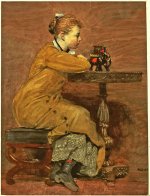Being a big fan of the Durbars I would say that it is likely a wooden elephant that was painted to make it a little more special and convey some of the grandure of the event. As Martin mentioned they do paint their elephants for various parades etc and it could well be that the model is a dipiction of an actual elephant that participated in the event but I cant say yes or no to that one since most of the illustrations I have seen of the 77 Durbar have been engravings or pen and ink drawings. There are photos of the major players involved which were bound in a book format but they are rather rare and I have never had the pleasure of looking through one. They did similar books for the other two Durbar's. So if you can find a copy of one of the 77 books it might just show this elephant. However I think its merely a tourist trinket made of wood. Great picture!
Dave
PS Here is the information on the book from 1877 (one for sale on ebay for about 2K)
"The History of the Imperial Assemblage at Delhi, held on the 1st January, 1877, to celebrate The Assumption of the Title of Empress of India by Her Majesty The Queen"including Historical Sketches of India and Her Princes Past and Present
by Wheeler, James Talboys,(1824-1897), with Portraits, Pictures, Maps and Plans. Published by Longmans, Green, Reader, and Dyer. Pages xiv+248 pp. with double-page color litho, 5 other lithos, 1 reproduction of an engraving and 26 mounted Woodburytypes( see explanation below) after photos by Bourne and Shepherd. All the pictures are present except Queen Victoria's engraved picture, not from a photograph. It was taken from a painting by Angeli and the engraved copy sent to India by Queen Victoria to be placed in the State Reception Tent. The photographs include studio portraits of Lord Lytton, and eleven Indian rulers; a group of the Khan of Khelat with Chiefs and Ministers; seven views of historical remains in Delhi; and five of scenes at the Durbar at which Queen Victoria was proclaimed Empress of India. 'The original photographs, with some exceptions (not stated which ones), were taken by Messrs Bourne and Shepherd' (Wheeler 1877, p.vi. ).
Apart from the historic occasion which this book recounts is the rarity of the photographs of the Indian Princes and architecture by the firm of Bourne and Shepherd. In 2006, at Bonham's, 25 of the pictures from the book, excluding maps and lithos and the Queen Victoria engraving, were auctioned off for about $3300.00. We have found only one copy of this book for sale on the internet and it is offered by UK Amazon and it is listed as being in poor condition (since changed to "acceptable") and offered in British pounds which converted to dollars at about $3300.00, depending on exchange rate.
Samuel Bourne's name is synonymous with British Indian photography. He is most well known for his photography of the Raj, and has become one of the most well-known photographers of India.
Bourne & Shepherd (1865-)
A partnership between Samuel Bourne and Charles Shepherd, the firm were commercial publishers of landscape and topographical views of India. Although based in Calcutta and Simla, where they operated portrait studios, their work was widely retailed throughout the subcontinent by agents and in Britain by wholesale distributors. This partnership between the two men was the last variant of earlier partnerships between Shepherd and Robertson, and Howard, Shepherd and Bourne. The company was purchased by Colin Murray in the early 1870s. Murray added much of his own work to the existing catalogue and continued the company well into the 20th century.


